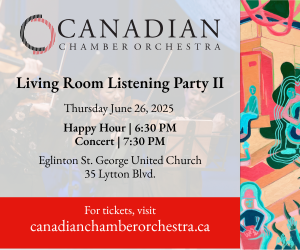By Paul Ennis
Robert Wilson’s and Philip Glass’s seminal opera, Einstein on the Beach, made its triumphant Canadian debut Friday at the Sony Centre in a production that defies convention to this day, 36 years after its first performance. Filled with contemporary 1970s pop culture references from Patty Hearst to Mr. Bojangles to a list of NYC radio station WABC deejays, Einstein is both a timeless piece about time and a spacious piece about space.
Two days before opening night in a fascinating panel that uniquely chronicled the work’s origins by the three principal creators – dancer/choreographer Lucinda Childs is the third -- Wilson said its inspiration was “20th century god Albert Einstein.” He explained that long duration plays always interested him – the production runs 4 hour and 20 minutes -- and that he saw opera as an expression of its Latin origin “works” as in “including all the arts.”
Einstein comprises four acts and five brief “Knee” connective interludes (Wilson calls them “close-ups”) and runs without intermission. The audience is welcome to come and go as it pleases. (Curiously, no one in the row I was in near the back of the Sony Centre’s main floor left their seats during the entire performance – except to stand at its conclusion.) The current production is the fourth since 1976 and the first since 1992. I was fortunate to attend the second at the Brooklyn Academy of Music in 1984, a mesmerizing experience as I recall. Based on that memory and recordings from the 1970s and 1992, this Luminato incarnation is indisputably the most musically proficient of the lot.
Wilson’s conceptual starting point for the opera, he explained at the panel, was a classical structure -- a theme and variations built around three images (a train, a trial and a field that would host a space machine). This solid foundation enables each scene’s individual elasticity to flourish. Wilson advised his audience not to look for meaning but to just get lost in it, quoting Susan Sontag: “To experience something is a way of thinking.”
Yet, Wilson did reveal that “On the Beach” alludes to the atomic bomb (specifically to the impending nuclear holocaust in Nevil Shute’s novel of the same name), that the train image is there because Einstein liked trains and that the lines of light, which slowly move in a myriad of ways throughout the opera, refer to time and space.
Wilson, trained as an architect, kept a notebook filled with drawings which were his ideas for Einstein’s visual content. When Glass came to compose the score at the piano he kept Wilson’s notebook in front of him. “The music came easily,” Glass said, attributing Einstein’s continued freshness after more than three decades to its being unlike any of their other collaborations. “It’s sui generis,” he said.
Einstein appears in several guises throughout the work, as a young chalk-wielding theoretical physicist and as a sailing afficionado, for example, but most memorably as a violinist wearing what was (apart from the Beatles’ mop tops) arguably the most iconic hairstyle of the mid-20th century. The wig was worn by the prodigious Jennifer Koh (who played Spring and Summer from Vivaldi’s The Four Seasons with the TSO in March as part of a “What Makes It Great” concert).
In an impressive evening filled with time-bending stagecraft, energetic dancing that seemed to embody the “E” in Einstein’s most famous equation and unparallelled musicianship from soloists, chorus and instrumentalists led by Michael Riesman, Ms. Koh’s vibrant playing ranged from her forceful impeccably phrased repetitive cycles of notes -- a touchstone of much of the opera -- to the warmth of the haunting second theme in Knee 4.
Two days earlier at the panel, Glass explained that the violin becomes a touchstone since the most important thing for a musician was that Einstein played the violin. As to why many of the lyrics consisted of solfege syllables (doh re mi) and numbers, Glass recalled that it started as a teaching device to get the singers used to his idiosyncratic tone palette and complex time signatures. Wilson happened to walk in on a rehearsal and expressed his pleasure with the “lyrics”. Glass kept them, the result of “my clumsiness and Bob’s naivete.”
Two more standouts in Friday’s performance were Andrew Sterman’s compelling tenor saxophone solo in Act 4, Scene 1 which soared Gato Barbieri-like as twenty-one people moved onto the stage individually or in pairs, stop-frame style and Kate Moran whose rendition of “Prematurely Air-Conditioned Supermarket” elevated Lucinda Childs’s eight lines of Laurie Anderson-like seemingly trivial consumerist insights into high performance art. That most of it was delivered while lying on a bed in front of a judge in the second trial scene (Act 3, Scene 1) only made it more remarkable. It was my personal show-stopping moment.



